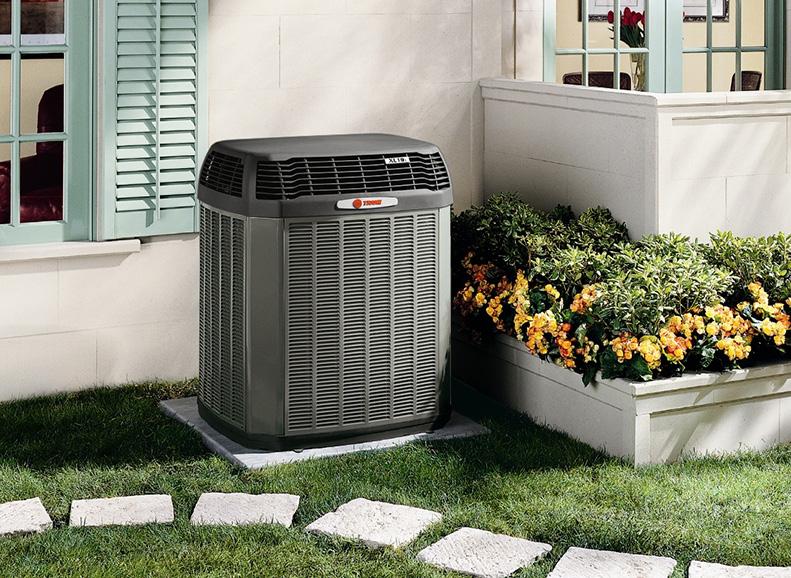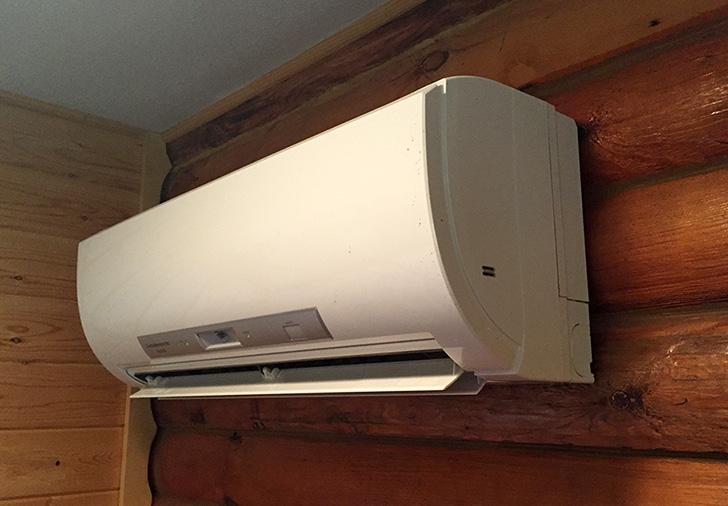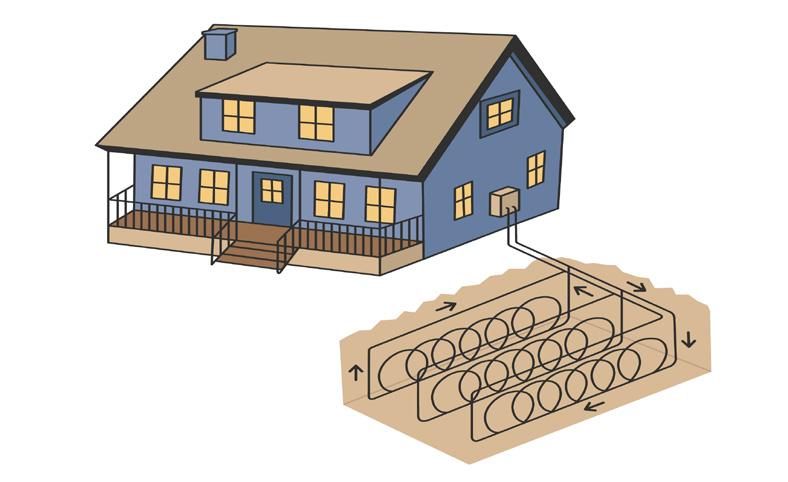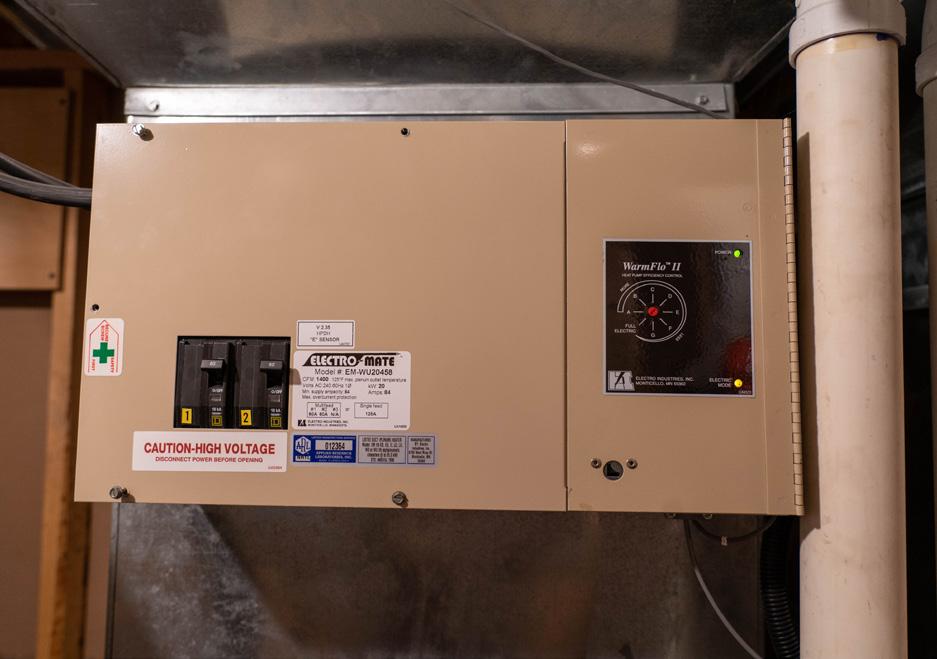
9 minute read
Electric Heating & Cooling
AIR-SOURCE HEAT PUMPS
Unlike a furnace, an air-source heat pump doesn’t burn fuel to make heat. It simply uses electricity to move heat from one place to another. Think of an air-source heat pump as a heat transporter constantly moving warm air from one place to another, to where it’s needed or not needed (depending on the season).
Even cold winter air contains some heat. When it’s cold outside, a heat pump extracts this outside heat and transfers it inside. When it’s warm outside, it reverses directions and acts like an air conditioner.
A standard air-source heat pump is a self-contained system that uses existing ductwork. The system is composed of an outdoor compressor unit and an indoor air handling unit. The two units are linked with refrigerant tubing and a connected electric supply wire. New advanced heat pumps called cold-climate heat pumps (CCHPs) operate efficiently down to belowzero temperatures, making this technology a new fan favorite for the cold of Minnesota and North Dakota.
BENEFITS
VERSATILITY – A single system delivers heat in the winter and cools your home in the summer.
EFFICIENCY - Because an air-source heat pump moves heat instead of generating it, the system delivers up to three times more energy than the electricity it consumes.
COMFORT – Your air-source heat pump will deliver steady, automatic climate control to your home – even when switched to a backup fuel source.
STABILITY – By taking advantage of your cooperative’s low-cost off-peak program, you can protect yourself against the volatile price swings of propane and fuel oil.
SAVINGS – In addition to your low off-peak rate, you can receive hundreds in rebates to help cover the cost of your technology upgrade.
Cold-Climate Heat Pumps
The Halvorsons’ story
At a cozy rural home just west of Glyndon, Minn., Mike and Mindy Jo Halvorson were settling into another chilly winter season. The Red River Valley Cooperative Power members have never been worried about high heating bills or cold toes – their coldclimate heat pump (CCHP) has ensured that.
“It’s always the temperature we set it at. It doesn’t fluctuate much,” Mindy Jo said, glancing to the living room’s digital thermostat. “I really don’t think about it at all, because it’s always consistent.”
The Halvorsons’ CCHP is an advanced style of air-source heat pump, which efficiently transfers heat instead of generating it. In the winter, it absorbs and transfers heat inside, and in the summer the unit works in reverse, removing heat from the home. Heat pump technology has come a long way since its introduction to the public in the 1970s.
“This isn’t your grandparent’s heat pump,” Mike said. “With the newer cold-climate technology, the compressors – as it gets colder outside – can ramp up and absorb more heat from the outside air and do it at lower temperatures.”
Mike is a Territory Manager for Auer Steel & Heating Supply Company, an Upper Midwest heating, ventilation and air conditioning (HVAC) distributor. Educating contractors about the best heating and cooling choices for consumers is a large part of his job, and air-source heat pumps dominate the conversation.

“Homeowners are starting to step up and ask for this now. Heat pumps are getting to be the big buzzword, and that’s why companies are putting a lot of their investment into engineering the technology,” he said. “The future of our industry is air-source heat pumps.”
With the improved engineering of CCHPs, the systems have become popular even in the coldest parts of Minnesota and North Dakota. The units are designed to transfer heat at as low as 20 degrees below zero, but the most efficient heating can be experienced at a balance point around 10 degrees – far lower than a standard heat pump. At that point, the system can switch to a backup heating source, like propane or hydronic.
As cooperative members, the Halvorsons take advantage of the off-peak program, through which they receive a reduced electricity rate (nearly 50%) to allow the co-op to control the CCHP if regional electric demand is too high. The switch to backup happens seamlessly with no interruption in comfort.
Mike explained that their CCHP efficiently covers 80% of the seasonal heating hours of their home. He adds that between the low off-peak rate, the large cooperative rebates available, and the current volatility of the fossil fuel market, installing an electric CCHP is an easy choice for homeowners.
“They all want to be comfortable, they want to lower their energy bills, and they want to do their part,” he said.
– Mindy Jo Halvorson
Electric Heating & Cooling
DUCTLESS MINI-SPLIT HEAT PUMPS
Similar to an air-source heat pump, a mini-split heat pump is run by a compressor unit placed outside of your home. That unit is connected to an indoor unit by small cables and a refrigerant line. The indoor unit is typically mounted high on the wall of the room that is being heated/cooled.

BENEFITS
VERSATILITY – A single system delivers heat in the winter and cools your home in the summer.
EFFICIENCY – The system only heats and cools the area that is necessary and transfers heat instead of generating it.
EASE – The system does not require ducts and can be installed easily in any room. It can be set to run automatically or by remote control.
SAVINGS – In addition to the money you will save in efficiency, the upfront cost of the unit may be covered in part by a rebate from your utility.
GROUND-SOURCE HEAT PUMPS
A ground-source heat pump (also referred to as a geothermal heating and cooling system) is based on the physical law that energy flows from a warmer place to a cooler place. The typical system consists of a closed loop of plastic tubing installed underground and an electrically powered compressor inside the home. An environmentally friendly antifreeze solution circulates through the tubing and captures the natural heat of the earth, cycling it to the home.

BENEFITS
EFFICIENCY – Because the system only uses electricity to move larger amounts of heat energy, the system may use up to 50% less electricity than conventional systems.
RELIABILITY – There are few mechanical components to the ground-source heat pump system, and because they are sheltered from the elements underground, you don’t have much to worry about years after installation.
RESPONSIBILITY – Ground-source heat pumps are one of the most environmentally friendly heating and cooling systems on the market today.
Electric Plenum Heaters
Easily adapted to an existing fuel oil or gas/propane forced-air system, a dualfuel electric plenum heater uses your existing furnace fan to move air across the plenum heater elements to heat your home. Both your fossil fuel furnace and the electric plenum heater use the same thermostat and ductwork.
Benefits
EASE – A plenum heater is one of the easiest ways to convert your existing propane or oil furnace into a dual-fuel heating system.
COST EFFECTIVENESS – The plenum is a cost-effective way to integrate reduced-rate off-peak electricity into your heating system. The technology also helps lengthen the lifespan of your gas furnace.
RESPONSIBILITY – The plenum is a safe and clean heating alternative for any home or building.

THERMAL STORAGE HEATERS
Electric thermal storage heaters convert off-peak electricity to heat and store this low-cost heat to keep a home comfortable 24 hours a day. The system contains electric heating elements that lie within specially designed, high-density ceramic bricks. These bricks are capable of storing vast amounts of heat for extended periods of time. The stored heat is automatically regulated in relation to outdoor temperature and the heating requirements of the user. When the room thermostat calls for heat, it is extracted from the unit’s storage core and distributed evenly in the home.
BENEFITS
EFFICIENCY – The heater’s ability to store inexpensive offpeak energy and efficiently deliver heat makes it one of the most advanced heating systems available.
RESPONSIBILTY – In addition to being 100% efficient, the system is clean – no backup fuels are needed.
EASE – Once the system is set up, it works with outdoor sensors to maintain the correct amount of stored heat throughout each season, creating year-round, worry-free comfort. It requires no tank filling or tune-ups and is virtually maintenance free.
VERSATILITY – Electric thermal storage heating offers several applications, including a central forced-air furnace, hydronic furnace or room unit – whatever best fits your home and needs.
SAVINGS – In addition to the money you will save with the low off-peak electric rate, your utility may also offer a large rebate to help cover any initial costs.
UNDERFLOOR HEATING
Underfloor heating has quickly become a favorite for those seeking ease and comfort on chilly days. The system can be installed at construction or during renovation. Warmth rises from the floor and spreads evenly through a room, garage or shop building. The technology can be applied two ways. Hydronic floor heating is used in conjunction with an electric boiler and circulates heated water through flexible piping. The piping can be installed right below the concrete in new construction projects or mounted below the floor of existing wood construction. Electric cables or mats heat up when electric current is applied. The systems are buried 8-12 inches deep in a bed of sand under the concrete slab, which serves as a heat storage reservoir.
BENEFITS
EFFICIENCY – The storage system efficiently stores offpeak heat and allows it to rise into a room uniformly across the floor.
EASE – Once you complete the easy installation of the system, there are no maintenance needs. You also don’t have to worry about heating vents being blocked by furniture.
VERSATILITY – The system can be used to heat an entire building or in supplement to another heat source.
RESPONSIBILITY – The system runs clean and no backup fuels are needed.
COMFORT – Not only is the system completely quiet, it also gives your feet some extra warmth on those cold winter days.






